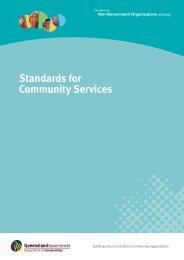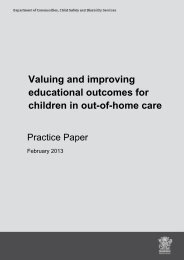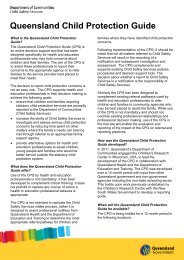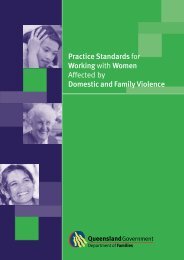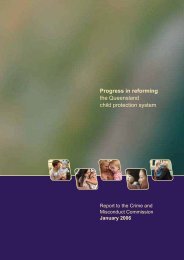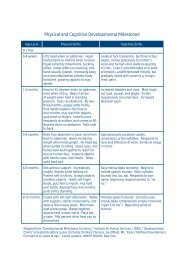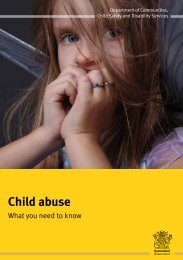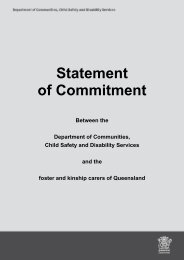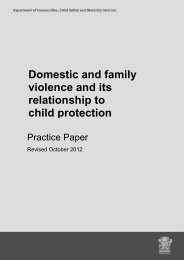Housing and Support Program (HASP): Final Evaluation Report
Housing and Support Program (HASP): Final Evaluation Report
Housing and Support Program (HASP): Final Evaluation Report
You also want an ePaper? Increase the reach of your titles
YUMPU automatically turns print PDFs into web optimized ePapers that Google loves.
activities, while others tried to connect clients to<br />
existing disability support groups in their communities.<br />
The intensity of support provided to each client<br />
remains unclear as it was based on client needs <strong>and</strong><br />
the willingness of the individual to accept support.<br />
Stage one provided support to 100 people with<br />
complex mental health problems <strong>and</strong> high levels<br />
of disability. The majority had schizophrenia (71.9%)<br />
<strong>and</strong> almost all (86.4%) had been hospitalised prior<br />
to entering the program. One in 10 had been living<br />
in unsatisfactory accommodation, including boarding<br />
houses, crisis accommodation, tents, or squatting.<br />
The most signifi cant outcome was the reduction in the<br />
need for acute inpatient care. Prior to joining the HASI<br />
program, clients had a total of 12,486 days in hospital.<br />
This is compared with 1,461 days (or a 90% decrease)<br />
in the 12 months following the program (Morris et<br />
al., 2005). Cost-effectiveness analysis indicates that<br />
the cost per person was estimated for start-up at<br />
$110,337.88 <strong>and</strong> a recurrent annual cost of $57,530.<br />
This does not include a number of cost factors, such<br />
as the recurrent program management costs by the<br />
NSW Health Department, the cost to HASI participant,<br />
family <strong>and</strong> other services providers (such as GPs),<br />
or foregone costs because resources (such as<br />
management <strong>and</strong> housing stock) were spent on<br />
HASI rather than elsewhere.<br />
‘Project 300’ – (Queensl<strong>and</strong>)<br />
‘Project 300’ was established in Queensl<strong>and</strong> in 1995<br />
with the aim of relocating 300 long-stay clients who<br />
were resident in the three psychiatric hospitals in that<br />
state back to their community of origin or choice.<br />
An independent evaluation of the initiative found<br />
that the Project 300 ‘model’ was able to maintain<br />
a group of formerly institutionalised people in their<br />
chosen community. Days spent in the community<br />
remained high <strong>and</strong> most people were engaged in<br />
some form of structured activity outside the home.<br />
The cost of keeping individuals in the community<br />
was about one-third that of keeping the same<br />
individual in hospital (Meehan et al., 2011).<br />
Follow-up at seven years post-discharge to the<br />
community found that while the majority of people in<br />
the study remained unemployed, many were involved<br />
in community activities. While some individuals had<br />
made signifi cant progress, there was no evidence of<br />
systematic gains in general functioning for the group<br />
as a whole. The evidence of successful community<br />
tenure, notwithst<strong>and</strong>ing in many cases, a history of<br />
unsuccessful discharge prior to the introduction of<br />
Project 300, suggests that the support worker role<br />
actively contributed to successful community tenure.<br />
Indeed, follow-up found that 40% of those discharged<br />
had not required admission to inpatient care in the<br />
seven years since entering the program. This is a<br />
remarkable fi nding given that almost all of the clients<br />
in the program had been in hospital for the two years<br />
prior to entering the program.<br />
Individual Tenant <strong>Support</strong> <strong>Program</strong> –<br />
(South Australia)<br />
The Individual Tenant <strong>Support</strong> Scheme in South<br />
Australia was established in the inner-south region<br />
of Adelaide <strong>and</strong> was designed for people with<br />
long-term mental illness at risk of relapse through<br />
an accommodation/support crisis. The scheme, which<br />
was in place from November 1994 to November 1996,<br />
was designed to provide support to tenants on a<br />
fl exible basis. This was achieved through a partnership<br />
arrangement between service users, service providers<br />
<strong>and</strong> community-based organisations (Desl<strong>and</strong>es &<br />
Kilner, 1997). The project had the unexpected diffi culty<br />
of being able to recruit the minimum target of 15 tenants<br />
at any one time. The reason for the low referral rate is<br />
unclear, but could have been a consequence of inbuilt<br />
prejudices, which made it very diffi cult to create good<br />
working relationships across the different sectors<br />
(Desl<strong>and</strong>es & Kilner, 1997). The project used a model<br />
of support based on Direct Care Workers (DCWs), with<br />
each individual receiving up to 21 hours of support per<br />
week. The fi nal report was critical of some DCWs being<br />
more enabling than others <strong>and</strong> this may have restricted<br />
the manner in which DCWs interacted with tenants <strong>and</strong>,<br />
therefore, limited options for community integration.<br />
The report was generally descriptive <strong>and</strong> very little<br />
information was available on the background of these<br />
workers, other than that they were non-professionally<br />
trained staff employed for a minimum of four hours per<br />
week <strong>and</strong> received training <strong>and</strong> orientation.<br />
<strong>Housing</strong> <strong>and</strong> <strong>Support</strong> <strong>Program</strong> (<strong>HASP</strong>)<br />
9



